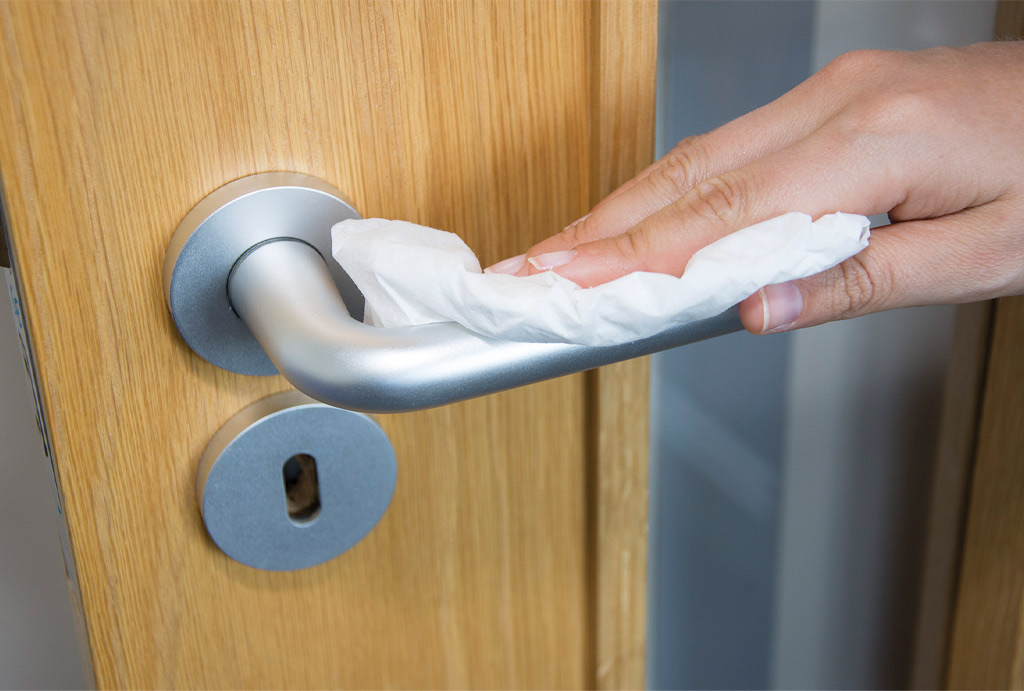Cleaning and disinfecting are similar, right?
WRONG!
There’s actually quite a stark difference between the two.
As we all become more clean-conscious, it’s definitely worth considering whether you’re actually using the right products for the right situation.
So, what exactly is the difference between cleaning and disinfecting? What are the most efficient ways to clean and disinfect your hands?

What is Cleaning?
Clean (transitive verb): ‘to make clean such as to rid of dirt, impurities, or extraneous matter’
Pretty straightforward really. Cleaning is simply the removing of dirt, grime, or grease from hands or surfaces.
This process typically involves soap and warm water. If you spill a fizzy drink on your hands for example, washing them with soap and warm water will remove the sticky residue. It will not, however, kill bacteria or other pathogens on the surface of your hands.
But doesn’t soap kill bacteria and viruses? That’s why we wash our hands with soap, right? I’m sure that I’ve seen lots of advertisements and media coverage urging me to wash my hands and stay safe in the current climate.
That’s not strictly correct and is a common misunderstanding. Soap washes bacteria and viruses off of hands and this is why it’s recommended that you wash your hands for at least 20 seconds – the more time spent scrubbing, the more likely you are to wash away the bacteria. This does not kill bacteria and pathogens though – it simply rinses them away onto another surface.
What is Disinfecting?
Disinfect (transitive verb): ‘to cleanse (a surface, a device, a supply of water, etc.) by destroying, inactivating, or significantly reducing the concentration of pathogenic agents (such as bacteria, viruses, and fungi)’
Whereas cleaning simply removes layers of grime off of hands and surfaces and washing away bacteria, disinfectant actually kills pathogens. This makes it an essential part of your cleaning routine. Using disinfectant is a far more effective way of removing pathogens, including bacteria and viruses.
So why don’t we all just use hand sanitiser instead of soap?
High quality, premium hand sanitisers contain disinfectant properties, but if a surface is unclean, the disinfectant is far less effective because it has to cut through the grime first.
Cleaning – removing dirt and impurities prevents bacteria and viruses from becoming trapped under these layers of grime.
By removing these layers of dirt, you can expose the bacteria and viruses to the full force of the disinfectant.
Top Tips for Cleaning and Disinfecting your hands
- Clean before you disinfect
Cleaning first removes sediments of grime, allowing the disinfectant to work on the surface and kill the pathogens.
- Always check the contact time for disinfectant and sanitising hand gels
If a disinfectant requires a specific amount of use or ‘contact time’, that means that you must utilise it for the specified period.
- Choose a disinfecting hand gel product with at least 60% alcohol content
The WHO (World Health Organisation) recommends hand sanitising products with more than 60% alcohol. It has been proven that sanitisers with under 60% alcohol are significantly less likely to kill the bacteria/virus.
Ideally, choose an anti-bacterial hand gel solution with >70% alcohol.
- Look for the EN Standards on disinfectant and hand sanitising gel
Look for EN standards on hand sanitising gel (e.g. EN1500, EN1276, EN1650, EN14476:2013 + A1:2015).
Products with EN Standards are scientifically endorsed to contain anti-bacterial properties. Choosing an anti-bacterial solution is a great way to ensure you’re keeping hands hygienically clean and sanitised.
Embrace Cleaning and Disinfecting

Cleaning and disinfecting are both crucial parts of the process.
Always clean first, using soap and warm water in order to remove layers of dirt and grime.
Then, disinfect with a 70% alcohol product in order to leave a surface free of bacteria and viruses.
When it comes to killing pathogens, utilising the best of both cleaning and disinfecting is the way forward.
So, What About Cleaning and Disinfecting Surfaces?
It’s no good keeping your hands clean and sanitised if the surfaces around you are harbouring bacteria and viruses. With this in mind, identifying areas of risk such as surfaces with a high number of contact points is a critical starting point.
Think doorknobs… stair handrails… printers… mobile phones… and PC equipment such as keyboards. All of these places have the potential to become pathogenic breeding grounds. It’s therefore imperative that they remain both clean and disinfected at all times. By wiping down contact points with surface wipes regularly – such as whilst you’re waiting for the kettle to boil or the printer to finish printing – you can make disinfecting part of your routine.
However, screens and surfaces require different approaches – especially digital touchscreens that often contain special coatings. For screens, we recommend AF Anti-bac+ Sanitising Screen Wipes because they’re alcohol-free whilst still killing up to 99.999% of bacteria and viruses tested*. High quality and fully-recyclable, these paper-based wet wipes are smooth on screens. Both products only require 30 seconds of contact time, meaning surfaces simply need to remain wet for 30 seconds in order for the anti-bacterial properties to take effect. And if you’re out-and-about, consider carrying a portable pack of multipurpose wipes with you!

